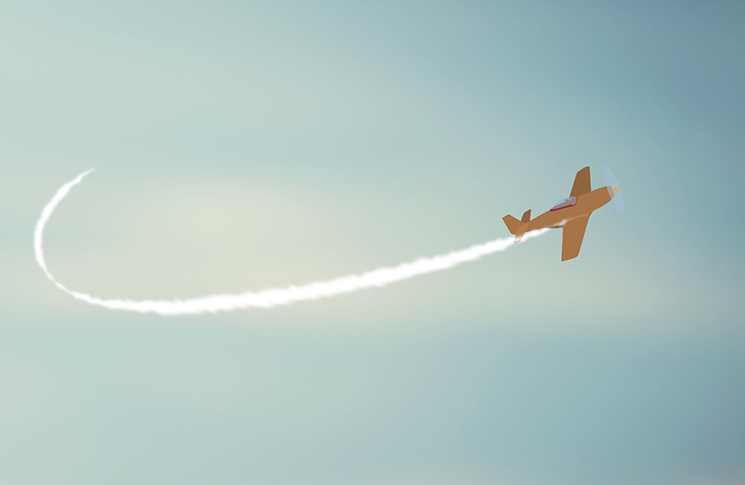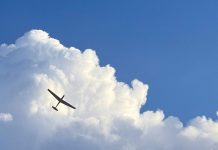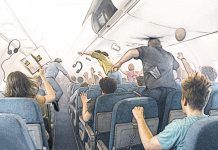Flight Safety Australia contributor and flying instructor Thomas P Turner has slowly and steadily acquired a lifetime’s wisdom from his and others’ mistakes. He’s still learning and happy to share.
I briefed my multi-engine student on rejected take-offs. With no brakes on my side of the aeroplane – normal in Beech Barons – part of the briefing was, ‘If I say brake, brake, brake – you brake, brake, brake!’
As we neared lift-off, the right engine rpm dropped. ‘Abort!’ I called, and then, ‘brake, brake, brake!’ But the pilot didn’t brake and the end of the runway was coming fast! I pulled both mixture controls to cut-off and the aeroplane stopped just a few metres from the end of the pavement.
On another day, my instrument student was ready for his flight test but we had never flown in actual instrument conditions together until this day. We departed and turned toward the first nav fix, entering clouds. As the outside world went grey, the aeroplane began to yaw left, right, left, right, in rapid succession. I first suspected an engine problem, but quickly realised my student’s right leg was twitching rapidly against the rudder pedal. Yes, it’s different in the clouds. I vowed to never send a student for testing who had not yet flown in IMC.
A student was ready for his first solo in the Cessna 150 – or so I thought. I watched from the ground as he came in way too fast for his first landing. I noticed the flaps were up. The aeroplane ballooned as he flared, with angle of attack high, and he wisely began to go around. But he didn’t lower the nose much or apply the rudder needed. The aeroplane began to drift left, nose high, and disappeared behind a hangar. Amazingly, he finally reduced the angle of attack and slowly climbed out. His second attempt was successful and, without prompting, he taxied in and shut down. I never saw him again. I had failed him as a trainer.
I earnt my flight instructor certificate 37 years ago. Reflecting on my time, I challenged myself to come up with 37 things I’ve learnt about flying and pilots, and from teaching pilots to fly.
What do I emphasise in instruction because of my experience?
Things I’ve learnt about flying
1. Aeroplanes seek the trimmed airspeed.
More correctly, a pitch-stable aeroplane will return to the same volume of airflow over the elevator. Raise the nose and it slows; release and it will nose down to return to the trimmed flow. Lower the nose and let go, and the aeroplane will pitch up. Add drag and it noses down; reduce drag and it pitches up. Add power and the nose rises; reduce power and the nose drops. The aeroplane may oscillate or ‘porpoise’ through a few cycles to find the trimmed condition, and some aircraft perform differently than others.
2. Power + pitch + configuration = performance.
For any flight condition, there is a combination of power setting, pitch attitude and configuration (flap and landing gear). Use the combinations and you can predict aircraft performance and attain the performance goal.
3. One inch of manifold pressure or 100 rpm equals about 100 fpm.
From cruise flight, if you reduce manifold pressure by about one inch, or in fixed-pitch propeller aeroplanes reduce rpm by 100, the aeroplane will enter a roughly 100-fpm descent at the cruise indicated airspeed. Reduce manifold pressure by about 5 inches or propeller speed by about 500 rpm and you’ll enter a roughly 500-fpm descent at cruise speed – an excellent way to make an en route descent. Find what works in your aircraft and use it.
4. The best use of an instrument rating is to find visual conditions.
Flying in visual conditions reduces fatigue and workload. It makes avoiding weather hazards far easier. Use your instrument rating to find clear air whenever you can. Even on an instrument approach, you must have sufficient visibility at or above a certain altitude in order to land.
5. Angle of attack (AoA) is more than academic.
It’s what makes your aeroplane fly. Think of AoA as the difference between the direction the wing is pointed and the direction it is going. More difference means more lift and drag, but when the difference becomes too great, the wing cannot develop sufficient lift to overcome weight and drag. An aeroplane can stall at any airspeed but can only stall when the critical angle (or difference) is exceeded.
6. Lift vector is as important as AoA.
Lift vector, that is, the direction lift is created relative to the aeroplane, is perpendicular to the relative wind. Banking the wing and reducing vertical lift causes the aeroplane to descend. This and the tendency for pitch to return to the trimmed airspeed is what creates a ‘graveyard spiral’ with an untrained or disoriented pilot.
7. Autopilots are very capable, very stupid copilots.
They will do exactly what you tell them to do, whether it’s what you intend or not. Learning modern avionics and autopilots can take as much time as learning the aeroplane itself. It takes time and study to realise the safety benefits.
8. Plan for endurance.
There is no range. How far the aeroplane can fly depends on weather and routing. How long it can remain aloft is much more important. I land with no less than one hour of fuel remaining. How far that gets me is irrelevant.
9. Strategy is part of the fun.
Enjoy a good technical challenge. When flying to the maximum endurance of the aircraft, work almost from take-off to ensure you’ll have sufficient fuel remaining when you land, not only to meet legal requirements but also personal limits. When weather is a factor, constantly re-evaluate your route, altitude and overall plan; never approach a hazard without knowing you’ll safely make it through. Approach hazards knowing which way you’ll turn, climb and/or descend to rapidly reach improving conditions. Plan and conduct flights so you stay within your limitations and those of the aeroplane, while always having a way out.
10. Flying is as safe – or as dangerous – as you choose it to be.
It’s easy to second-guess after the fact, sitting at zero altitude, zero airspeed and one G. The challenge is to make good decisions before a flight that address most of what you’re likely to see en route. That’s what commercial operations do with standard operating procedures (SOPs) and their safety record reflects it.
11. Mastery is the goal.
Passing the flight test only proves that you met the minimum acceptable standards on that particular day. The true goal is to get much better, so that even when fatigued, you’ll meet no less than the minimum standard on your worst flying day. I will never completely master flying, and my performance may vary from day to day. But I continually work to improve my skills and exercise them on every flight. I hope you do as well.
Personal minimums are pointless if you abandon them when they’re inconvenient.
Things I’ve learnt about pilots
12. Most pilots want to learn.
The problem is that flight training is delivered as a series of relatively short syllabi to achieve a specific goal, e.g. an instrument rating. Often it does not guide the pilot on how to maintain and increase skills after the flight test. Ask your instructor and other pilots to help you create a strategy for ongoing education and improvement.
13. Time is the biggest impediment to learning.
Cost is a factor, but making time for practice and study is hard for everyone. The key is to learn efficiently by following a plan and scheduling regular times for practice and study.
14. It’s hard to know when you have gaps in knowledge or experience.
There are many things to learn about flying that go beyond the minimum requirements. It’s challenging to identify gaps so you can address them, especially tasks you don’t perform regularly. Fly with a friend and have them critique your performance, then do the same for them. Schedule an instructor more frequently than regulation requires for quality control. Watch videos from known expert sources.
15. Knowing how and where to get information needs to be better addressed.
There’s a tremendous amount of information – some good, some good but not applicable to your aeroplane or how you fly it and some outright dangerous. Good information goes well beyond sources introduced in most pilot training, and deeper into many of the sources than most students see.
16. Vetting information to know if it is correct and complete is very hard.
Go to original source material – current regulations and the pilot’s operating handbook (POH) for the specific aircraft – to confirm opinions and presentations you see online or hear at the aerodrome. Be sceptical.
17. It’s hard to believe it can happen to you.
After-the-fact musings about accidents and emergencies don’t accurately reflect unexpected occurrences, make you quickly gather information and evaluate options under stress. They also do not address the need at times to make a fast decision with incomplete information. The defence is preparation.
18. Pilots usually know when they are breaking the rules.
Aviation culture is full of risk-taking and rule breaking. Fictional pilots rarely become heroes by following SOPs. Social media, pilot discussions, videos that pilots post about themselves and many accident investigations suggest that pilots who break the rules consciously chose to do so. Sometimes they get caught, sometimes they have an accident and sometimes they get away with it and are emboldened to do even more.
19. In emergencies, pilots often focus too much on solving a problem and not enough on flying with what capability is left to get safely on the ground.
Abnormal and emergency procedures are designed to minimise or eliminate an immediate threat. Analysing why something happened is usually best done on the ground.
20. The closer you get to your destination, the harder it is to divert.
I’ve been within 30 nm of home on a 700-nm trip, when I diverted because of weather. I once saw a vintage warbird fly over my home airport and later learnt it ran out of fuel just short of its home base less than 8 nm away. Criteria for diversion should be independent of distance to destination.
21. Personal minimums are pointless if you abandon them when they’re inconvenient.
Time spent evaluating risks is wasted if you don’t take advantage of your low-stress decisions at high-impact times.

Things I’ve learnt from teaching pilots to fly
22. The first step on every emergency checklist is, ‘fly the aeroplane.’
Writers of aircraft flight manuals and POHs appear to believe this goes without saying. My instructional experience and accident history suggests otherwise.
23. The second step on every emergency checklist is, ‘aim somewhere.’
You may be able to fix the problem, but you don’t want to fly away from your best (or only) option while you try, in case you can’t.
24. Emergencies are taught as events but are really the beginning of scenarios.
‘Engine fire in flight’ quickly turns to ‘engine failure,’ then ’emergency descent’ if the fire doesn’t go out, or ‘maximum glide’ if it does, followed by ‘landing without power’ on or off a prepared surface, and finally ‘evacuation’ on the ground. In the classroom, briefing room and aircraft, take every abnormal and emergency scenario to its logical conclusion for maximum learning.
25. Fuel, air, ignition.
All combustion engines have the same 3 needs: fuel, air and a source of ignition. If there’s an engine problem you can fix while sitting in the pilot’s seat, you’ll do so by confirming or changing the position of fuel, air (including carburetor heat as applicable) or ignition controls. Knowing this makes engine failure actions easy to remember.
26. Flight reviews are about improvement.
Most pilots will never take another flight test. The flight review is the only quality control they get and the only opportunity to guide them toward improvement.
27. Lack of an accident does not mean the flight was safe.
Luck saves a lot of pilots. Make skillful choices so you don’t have to rely on luck.
28. Final approach check.
Confirm the aeroplane is on speed, in configuration, on glidepath to the touchdown zone and in alignment with the runway centerline with no sideways drift. If you don’t hit all these targets by a predetermined point before you cross the runway threshold, go around.
29. Transitions.
We need time and training for all transitions. Learning to fly lighter aeroplanes is just as critical as training to fly larger ones.
30. Procedure versus technique.
Things that must be done are procedures and you should fly ‘by the book’. Other tasks are techniques and allow for variation. For example, with retractable gear the procedure is to extend the gear and confirm it’s down before landing. A technique is to extend the gear in the circuit abeam the threshold. You can extend it somewhere else but confirm it’s down before you land.
31. Limitations versus recommendations.
Airframe and engine limitations, established by the manufacturer and upheld by regulation, are mandatory. Limitations are in Section II of the aircraft flight manual, in POH supplements, regulations and in airworthiness directives. Everything else is best recommendation for operation. But you can do things differently if you do not violate a limitation.
32. To get ‘book’ performance, you must use ‘book’ technique.
If you want to get handbook performance, you must use the technique it recommends.
33. The student’s job is to fly the aeroplane.
The instructor’s job is to assure the safe outcome of the flight. Sometimes training objectives need to be sacrificed for safety. The instructor must remain vigilant at all times.
34. Teaching = learning.
There’s no better way to learn something than to teach it. There’s great satisfaction in helping others.
35. The longer I teach, the more I find it’s about communication.
Briefing is the key to a good flight and debriefing is vital to learning its lessons. Surprises will happen, but your response should not be one of them.
36. I’ve learned a lot more than just these things.
37. I’ve got a lot more to learn.
Ask yourself what you’ve learnt after every flight.
Visit the pilot safety hub.
Whether it is tips on radio calls, situational awareness, weather and flight planning or runway safety, you will find relevant information.
Refresh your knowledge before your next flight at the pilot safety hub.





